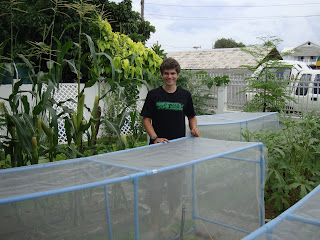Various pests, especially snails during the rainy season, make vegetable gardening a challenge. However, as we would like the ECHO Asia office demonstration garden to be as productive as possible year round, we decided to make protective row covers for our garden beds. ECHO Asia intern, James "Tarantula Boy" Manson (http://sustainabilityquest.blogspot.com/2010/09/spiders-over-snakes.html) was drafted for the job. Using 1/2 inch PVC pipe and row cover fabric, James constructed five row covers. We're so impressed with James' design that we dubbed it the "James 2000."
Measuring 1.45 meters long, 0.8 m wide and 0.9 m tall to be an exact fit for the beds, the total cost of materials for each unit was 397 Thai baht (US $13.26). Not terribly cheap. However, local materials, such as bamboo for the frame, could be easily used to lower costs.
Our James 2000s are study, lightweight and easy to move. However, they must be anchored to keep strong winds from blowing them over.
In case readers are interested in making their own versions of the James 2000, it is important to allow the mesh to make enough contact with the soil surface in order to be "sealed" with pieces of wood or brick to prevent pests from crawling under the frame. If heavy enough, such items will help keep the row covers from blowing over.
You can see that at least one snail was thwarted from entering a garden bed. Well made row covers can exclude a wide range of pests that are too large to pass through the mesh. On the other hand, pre-existing, resident pests will be confined by the covers. Row covers can also help prevent pollinators from entering; which is either good (if we're trying to prevent cross-pollination) or bad (if our crops need cross-pollination).
James' row covers are well made and we expect them to last at least a few years with minimal maintenance.
Subscribe to:
Post Comments (Atom)







No comments:
Post a Comment